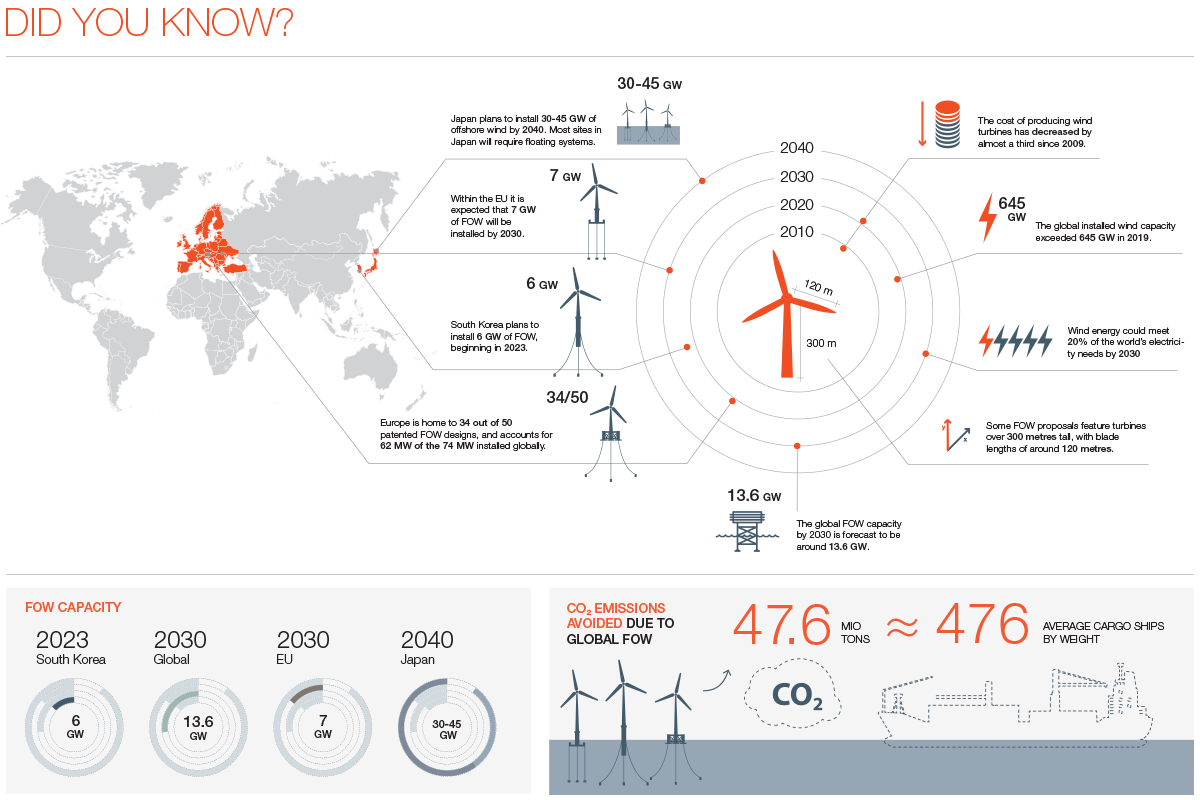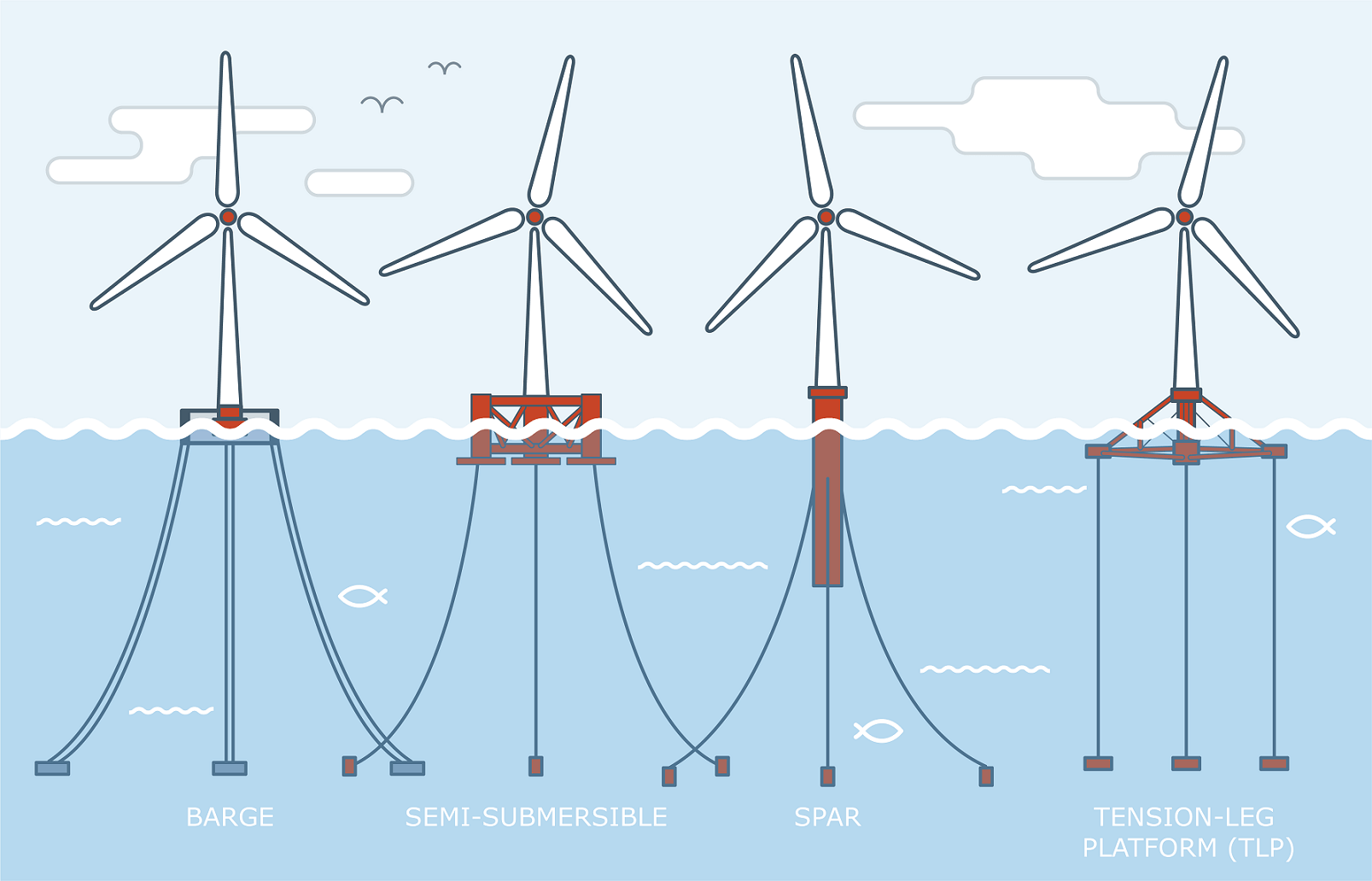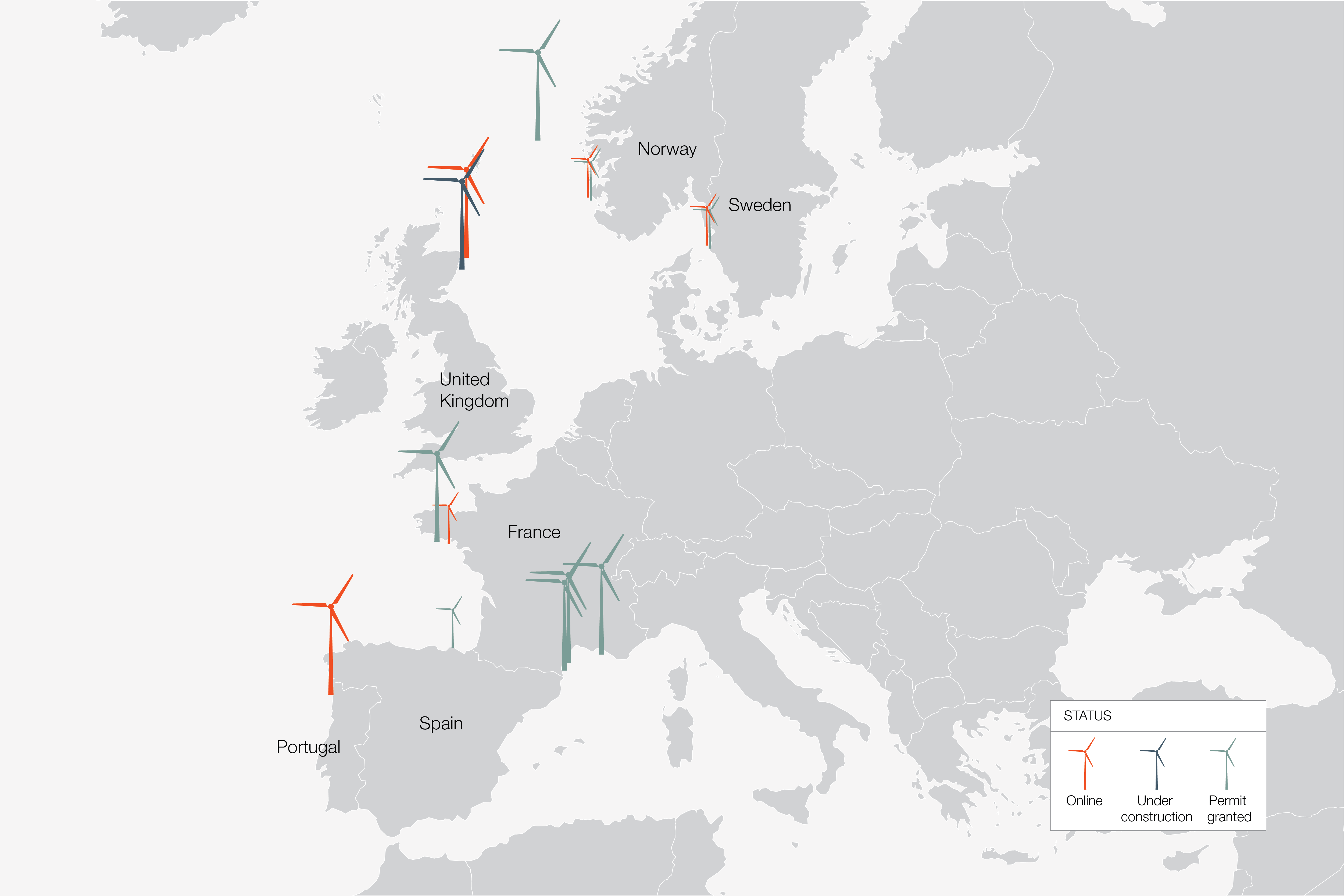OCEANS UNLOCKED - A FLOATING WIND FUTURE
14.06.2021 / Erlend Gjelstad Jakobsen and Nikolas Ironside
Today, the wind energy sector consists of two main categories - onshore wind and offshore bottom-fixed wind. An emerging category, floating offshore wind (FOW), has entered a phase of rapid growth and investment, and looks poised to become an essential third pillar of wind energy generation.
Picture being out at sea for a moment, in the wildest storm you can imagine – thundering waves colliding in a churning mass of sea foam, squalls of icy rain, and, of course, the howling gale whipping across the surface. Imagine now, in the heart of this storm, a wind turbine the height of the Eiffel Tower, bobbing on the waves, doggedly capturing the energy of the wind while withstanding the full force of nature’s fury.
You’d be forgiven for thinking this sounds a little far-fetched, but in recent years technological advancements have reached a point where deep water floating offshore wind (FOW) is not only undergoing intense research and development, it is on the cusp of becoming mainstream.
The appeal is evident. Turbines mounted on floating substructures can be installed in water as deep as 800 metres, unlocking the estimated 80% of global offshore wind resources that lie beyond the reach of bottom-fixed offshore wind. As backlash grows towards the visual and noise pollution from onshore and nearshore turbines, FOW has the potential to become an integral part of the wind energy industry, and the global green transition.
Turbines generating power for us in remote areas of the ocean seems like a no-brainer, yet concerns remain, particularly over the cost-benefit ratio. Claims that electricity from FOW could cost thrice as much as that produced by onshore turbines has led to calls to focus on existing technologies to achieve emissions reductions targets. Other concerns relate to maintenance demands and longevity in the corrosive marine environment.
Nevertheless, the technology continues to mature, and the challenges raised are constantly being addressed. FOW appears to be following the trend experienced by onshore and bottom-fixed wind, where prices fell as new innovations fuelled efficiency gains. Aside from access to more powerful and consistent winds, floating systems can leverage much of the existing wind supply chain, and support much larger turbines than bottom-fixed designs. Larger turbines mean more energy.
According to Erlend Gjelstad Jakobsen, Associate Project Director, Marine & Foundation at COWI in Norway “the consensus is that the technology will reach maturity by 2030, by which time the total amount of installed FOW capacity is expected to be around 10% of the total bottom-fixed capacity. With 80% of available wind resources sitting beyond the range of bottom-fixed turbines, FOW has the potential to eventually surpass bottom-fixed wind as the dominant offshore technology.With 80% of available wind resources sitting beyond the range of bottom-fixed turbines, FOW has the potential to eventually surpass bottom-fixed wind as the dominant offshore technology.
In a massive vote of confidence, a 2019 report from the International Energy Agency stated that offshore wind, including floating wind, is capable of producing 11 times more electricity than the world needs, and could attract around USD 1 trillion in investments by 2040. Let’s dive deeper into where the technology is now, and where its headed.
THE INEVITABLE ADVANCE OF FLOATING WIND
Recent years have seen a surge in bottom-fixed offshore wind developments, with ambitious projects such as the 13 gigawatt (GW) Danish Energy Islands continuing apace. However, an upper depth limit of 60 metres has limited development to areas fortunate enough to have relatively shallow seabeds. In fact, 71% of the planet’s surface is covered by water more than 200 metres deep. For countries surrounded by plunging continental shelves, FOW provides the first real opportunity to tap into their ocean resources for clean energy production.
A key advantage FOW has over existing wind technologies is its distance from most human activities. It doesn’t take up land which could be used for more productive purposes, and moving turbines away from coastal waters can create more open and less hazardous shipping channels. There are ecological benefits too – floating turbines can more easily avoid migratory flight paths and breeding & feeding grounds, thus reducing bird and bat deaths.
Aside from the obvious use of electricity generation, the sheer amount of available wind resource in deep waters gives FOW the potential to play a number of roles in the green transition: powering electrolysis to produce clean hydrogen fuel, desalinating seawater, and decarbonising energy intensive extraction industries, to name a few.

A BOON FOR PORTS AND THE MARINE INFRASTRUCTURE INDUSTRY
The expansion of FOW is expected to be a boon for ports and the marine infrastructure industry. Most floating designs require dedicated port facilities for construction, maintenance and installation, and coastal regions in decline could repurpose their infrastructure into FOW focused facilities. Floating systems require far fewer marine operations than bottom-fixed systems, and being able to service them onshore, or in the safety of a harbour, is a big plus. The buoyant substructures that house the turbines are designed to withstand the wild forces of the open ocean, resulting in reasonably long lifespans of around 20 years.
To unlock the full potential of FOW, significant investments in transmission infrastructure will be needed. Erlend Gjelstad Jakobsen explains that “transmitting energy over such large distances requires robust, dynamic submarine cables, designed to withstand a lifetime of constant movement. As floating wind sites are typically further offshore than bottom-fixed wind, dynamic cables with up to 220 kV voltage will be necessary. Moreover, FOW dynamic cable requirements exceed what is currently in use by the offshore rig industry, presenting another challenge for developers.” Floating turbines can also connect to offshore substations, or an energy island, from where the electricity is either distributed further or converted to green fuels.
The economics of FOW is an interplay between the construction and installation costs, offset by the increased power production from more energetic conditions. Bringing down the costs of a FOW system requires good old-fashioned industrialisation, to achieve an economy of scale. The floating substructure has been identified as having the single largest cost reduction potential, and a benefit of FOW is that as the size of turbines increases, the cost of the substructure doesn’t scale up linearly. A floating turbine could be twice the size of a bottom-fixed one, generating twice the power, and the cost of its foundation would not drastically differ from if it were half the size.
As Erlend Gjelstad Jakobsen explains, “the main challenge for offshore wind is price parity, the levelized cost of energy (LCoE) that is palatable to ratepayers. Now that floating technology has proven to be viable, it is a matter of reducing the LCoE, as has occurred with bottom-fixed wind. For COWI, our approach to the market is to provide non-patented solutions, which enables us to adapt designs to the limitations and opportunities present in the supply chain. This is the same approach we’ve taken in the bottom fixed market, which has been crucial to promote serial production and bring down costs. As every project is unique, we have a mindset which allows our contractors and developers to specify how they would like to fabricate and install their systems, and we adapt the design accordingly.”
DESIGNED TO WITHSTAND SOME OF THE MOST HOSTILE CONDITIONS ON THE PLANET

The four main FOW typologies: (L-R) pontoon/barge, semi-submersible, spar buoy and tension leg platform
The main point of difference between FOW and other wind technologies is the buoyant substructure. The four main designs, known as typologies, are:
- Single point anchorage (Spar) buoy systems.
- Tension leg platform (TLP) systems.
- Semi-submersible systems.
- Pontoon/barge (P/B) systems.
Each typology has advantages and disadvantages. The most suitable design always depends on the conditions of the site, and the project requirements.
Single point anchorage (Spar) buoy systems:
Spar buoy substructures have the simplest shape and are one of the easiest and cheapest to produce. A long, cylindrical draught, extending around 80 metres below the surface, is weighted to keep a low centre of gravity. The large draught makes the spar buoy best suited for very deep waters, and provides high resistance to wave pitch and roll forces. Spar buoys are moored by catenary chains and drag embedment or suction anchors. They are one of the most complex systems to install, as the substructure must be towed to the location and submerged, before the turbine can be installed on top by a derrick crane barge.
Tension leg platform systems:
TLP substructures are already widely used for offshore oil and gas platforms, and are best suited to water from 70 to 200 metres deep. They feature a submerged central column, anchored to the seabed by taut, vertical tendons, which limit motion during pitch and roll. Vertical moorings require higher holding forces than catenary chains, making them more expensive to install, and more sensitive to extreme weather, earthquakes and soil liquefaction. On the other hand, the vertical mooring has a much smaller footprint than other typologies, an advantage in sensitive ecological areas such as whale migration routes.
Semi-submersible systems:
Semi-submersible substructures consist of large columnar tubes, connected to each other and partially submerged. One column might host a single turbine, all the columns might host turbines, or a turbine may be held in the centre by bracing. Semi-submersibles utilise catenary chain mooring and drag embedment anchors, and are well suited to most water depths. Along with P/B systems, they can be towed to their site intact and are the easiest to install, requiring only tugboats and anchoring vessels.
Pontoon/barge systems:
P/B systems consist of a steel or concrete hull, anchored to the seabed via catenary mooring lines. These pontoon hulls can carry multiple turbines, maintaining stability via distributed buoyancy and a large weighted waterplane area. A drawback of the P/B design is its sensitivity to wave roll and pitch movements, making them better suited for calmer waters.
The industry is increasingly focused on ease of onsite installation, and designs that can simply be floated out intact and connected to undersea cables are seen as inherently advantageous. Semi-submersibles are the easiest to build, and are currently receiving the most attention, but the best design for any given project always depends on the location.
WHERE WE ARE TODAY – AND HOW DID WE GET HERE?
The idea of large-scale floating wind turbines was introduced by Professor William Heronemus from the University of Massachusetts in 1972, but the topic first began to appear on the radar of the mainstream research community in the 1990’s. It wasn’t until 2007 that the world’s first FOW turbine was deployed, but since then deployments and advancements have begun to snowball.
Below are some key moments in the FOW timeline so far:
December 2007: the world’s first FOW turbine, a TLP, was deployed 21km off the coast of Apulia, Italy, at a depth of 113m. The turbine gathered data on wind and sea conditions and was decommissioned at the end of 2008.
September 2009: The first large capacity FOW turbine was installed, a spar buoy structure named Hywind, operating 10km southwest of Karmøy, Norway. The design consisted of a 120 m tall turbine, with a capacity of 2.3 MW, located at a depth of 220 m. In 2010, Hywind survived 11 m waves with no damage, and by 2016 had produced 50 GWh of electricity.
September 2011: The second grid connected full-scale turbine, a semi-submersible, was installed in Portugal, producing 17 GWh of electricity over 5 years. It was decommissioned in 2016.
November 2013: Japan launched the Fukushima FOW farm demonstration project, featuring three turbines on semi-submersible substructures. The project reached its capacity of 12 MW in 2016, and is scheduled for decommissioning in 2021.
October 2017: When Hywind Scotland was installed 29km off Peterhead, Aberdeenshire, it became the world’s first commercial FOW farm in operation. It features five 6 MW turbines on spar buoy substructures.
October 2017: A turbine on a barge substructure, with a capacity of 2 MW, was installed off the coast of France.
July 2020: A three turbine, 25 MW FOW farm, the world’s first semi-submersible farm, was installed off the coast of Portugal, generating enough energy to supply 60,000 customers each year.
THE RACE TO LEAD THE MARKET IS HEATING UP
The 2020’s will be characterised by a plethora of ambitious new FOW projects, as the technology continues its march towards maturity. By solving the challenges specific to floating wind, countries and companies that move early stand to gain the most from exporting their technology, expertise and key learnings. Currently, Europe is leading the pack, but plans in Asia are no less ambitious, and there are few coastal regions in the world where FOW at some scale would not be a worthwhile investment.


Current and planned FOW projects & demonstration in Europe and Asia.
Some notable developments planned for the coming years are:
2022: Following the success of Hywind Scotland, the 88 MW farm, Hywind Tampen, is due to be installed in Norway. The farm will consist of 11 turbines on spar buoy substructures.
2023: In France, the 24 MW EolMed project will feature three turbines on barge substructures, and will be installed in the Mediterranean Sea.
2023: South Korea’s first floating wind project will commence construction, with an initial capacity of 500 MW. This will eventually grow into five projects with a capacity of 2 GW.
Mid 2020’s: In the US, the 150 MW Redwood Coast project is being planned. It will use a semi-submersible typology and will be situated off the coast of Humboldt Bay, California.
It’s no secret that COWI views wind energy as an international business priority, and is cognizant of the window of opportunity available to carve out a leading position in the floating wind market. The business is currently involved in commercial projects in Europe and North America, and is investing in several research & development projects, together with key industry players, to improve the interface between turbine suppliers and substructure designers, and develop a more efficient methodology for integrated load analysis.
Erlend Gjelstad Jakobsen states that “the rise of floating wind is exciting for COWI, as we’ve already proven ourselves as extremely competent full-service providers in the wind energy and marine engineering markets. Many of the skills we’ve honed on onshore and bottom-fixed projects are transferable, and the points of difference present us with a new realm of engineering to dive into. A number of our key account clients are involved in developing and trialling FOW, and we have a strong local presence in a number of the important emerging markets.”
Many of the skills we’ve honed on onshore and bottom-fixed projects are transferable, and the points of difference present us with a new realm of engineering to dive into.
Speaking further to this, Ron Heffron, Senior Vice President of Energy & Marine at COWI in North America says: “At COWI, our competences will serve us well as we enter this market, but much like with our work on bottom-fixed offshore wind foundations, we don’t endorse one specific typology. We prefer to design systems which best serve the unique needs of the location and the developer, considering environmental factors, local content requirements, water depth and so on. As with other wind technologies, our role is to be independent advisors capable of working with all technologies.”
With investments and subsidies growing, government action plans solidifying, and regions which missed out on the first wave of offshore wind grasping this new opportunity, it’s hard to imagine the global rollout of FOW slowing down anytime soon.
As we move beyond the era of fossil fuels and harness instead Earth’s natural forces, it’s worth reflecting on how preposterous the idea of floating wind turbines would once have seemed. It just goes to show that when curiosity, determination, co-creation and technology collide, even the most far-fetched ideas can be realised. Ideas like an ocean of Eiffel Tower sized wind turbines, floating in the deep, unscathed by the waves and unbowed by the wind.
5 key takeaways:
- Floating offshore wind turbines can be installed in water as deep as 800 metres, accessing an estimated 80% of the global offshore wind resources.
- A 2019 International Energy Agency report stated that offshore wind, including floating wind, has the potential to produce 11 times more electricity than the world needs.
- Aside from electricity generation, floating wind has the potential to play a number of roles in the green transition, including producing clean hydrogen fuel, desalinating seawater, and decarbonising industries.
- The main point of difference between FOW and other wind technologies is the buoyant substructure. There are four main typologies: spar buoy, tension leg platform, semi-submersible and pontoon/barge.
- The idea of large-scale floating wind turbines was first introduced in 1972, but the topic first began to be widely researched in the 1990’s. In 2007, the world’s first FOW turbine was deployed.
MEET THE EXPERT
It’s important to me that my work has meaning. I feel privileged to be an engineer at such a dynamic time, taking part in a new industry adventure that is rapidly developing. Floating wind is seeing immense technological progress, which means that those of us working in the field get to try out a variety of roles and battle new technical challenges. All in all, every single project is demanding and professionally challenging, and we’re learning a lot. I started my career working with offshore floating structures, so for me it represents a great opportunity to utilise that competence to aid the transition to green energy.
Get in contact

Erlend Gjelstad Jakobsen
Associate Project Director
Marine & Foundation, Norway
Tel:
+47 975 37 070
edjn@cowi.com